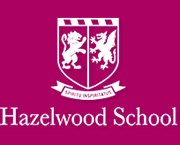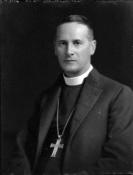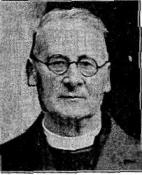
War Memorial
| Chaplain Guy VERNON-SMITH MC Order of the Redeemer (Greece) | |
|
2/5th (City of London) Battalion (London Rifle Brigade) Date of birth: 15th October 1880 Date of death: 11th June 1957 Died aged 76 Unknown |

|
| Guy Vernon-Smith was born at 12 Fellows Road, Hampstead on the 15th of October 1880 the eldest son of Vernon Russell Smith and Eliza Gertrude (nee Lovell) Smith of 7 Strathsay Gardens, Hampstead. He left Hazelwood School at December 1893 for Winchester College where he was in Fearon’s House from January 1894 to 1899. He went on to New College Oxford in 1899 where he received a 2nd Class Degree in modern history in 1902 a BA in 1903 and an MA in 1906. From 1904 he worked as a barrister at Lincoln’s Inn and was called to the bar in 1905 but later that year he went to Wells Theological College and in 1906 took holy orders becoming a Deacon the same year and a Priest in 1907. In 1906 he began work as Chaplain of Romford, leaving in 1909 when he went to work as Chaplain of Oxford House in Bethnal Green. In 1911 he was appointed as Resident Chaplain to Arthur Winnigton-Ingram the Bishop of London, a position he held until 1918. On 24th of July 1914 he was appointed as Deputy Priest to His Majesty at the Chapel Royal, being deputy to the Reverend D. Aitken-Snead, a position he held until 1916. On the outbreak of war he was given leave by the Bishop of London to join the armed forces and on the 19th of October 1914 he was appointed as 4th Class Chaplain to the Territorial Forces and was attached to the 2/5th (City of London) Battalion (London Rifle Brigade) with the rank of Captain. He joined the battalion while they were in training at Haywards Heath in early 1915. At Easter 1915 he accompanied the Bishop of London on a visit to the troops. During the visit the Bishop conducted a number of services near to the front line and visited Casualty Clearing Stations to cheer the wounded men there. The Bishop was Chaplain to the 1/5th (City of London) Battalion (London Rifle Brigade) but was unable to visit the battalion in the front line at Ploegsteert Wood as he was forbidden to by the Commander in Chief so Vernon-Smith was sent in his place. Guy Vernon-Smith published a book on the visit entitled "The Bishop of London's visit to the front" published by Longmans, Green & Co in 1915. On the 5th of February 1916 he assumed the duties as Chaplain to the 5th (London) Division. On the 24th of January 1917 he sailed with his battalion from Southampton, arriving at Le Havre the next day. On the 16th and 17th of May 1917 the battalion was involved in fighting around Bullecourt and that evening Guy Vernon-Smith gathered together some volunteers to place crosses on the graves of those who had fallen during the action. As they neared the front line the battalion who were occupying it at the time launched a local attack to improve their position. During the barrage and counter barrage he and his men were pinned down for two and a half hours after which they returned to Mory with no casualties among them. On the 16th of June 1917 the 2/5th (City of London) Battalion (London Rifle Brigade) was again in action at Bullecourt and after their attack a number of wounded were trapped in no man's land. Guy Vernon-Smith decided to mount a rescue operation and gathered a party of forty eight volunteers, one of whom was 2nd Lieutenant W.H. Richardson who described the events which followed:- "We left our rifles and equipment behind and in good order we went overland following Guy Vernon-Smith--as each Very light went up so we all fell down. As Guy came to each wounded man he saw they were comfortable and told the lads to carry them back. To be sure none would get lost he arranged for a signaller to keep flashing a light at the point where we were to meet, and ambulances were waiting to take the men to hospital. I had never had anything to do with stretcher bearers before, and the three lads who were with me were great. It came to our turn to take a Scotch laddie who was wounded in the leg, and when he was comfortable we looked round for the flashing light and began to make our way as carefully as we could over the rough ground in the dark towards that light. We could see others in front by their movement as it was very slow I cannot say how many times we had to fall down with our stretcher each time Jerry sent up a Very light but by the time we had reached our destination it was getting light. Our wounded comrade thanked us for bringing him safely behind our lines. He said he was so afraid when he was out there for 3 days and nights that Jerry would come along, and he didn't know what would have happened. Guy came in with the last stretcher and by then it was quite light......I was always glad I was able to help that night, when you received such sincere thanks from a wounded comrade". The papers recommending that he be awarded a medal for gallantry described his actions:- "During the operations of the 14/15th and 15/16th of June near Bullecourt he never rested in his attention to the wounded both by the regimental aid post and in the open. On the 19/20th he insisted on accompanying a party of volunteers to get in some wounded men who had been lying out for four days and attached himself to the part which had the most dangerous tack; he greatly encouraged the men by his personal example and courage and gave them confidence when they met with heavy machine gun and rifle fire . He was altogether over six hours away being the first to go out and the last to return. He is a splendid type of Padre and has always been untiring in his duty." He was awarded the Military Cross which appeared in the London Gazette of the 25th of August 1917. The citation read:- "For conspicuous gallantry and devotion to duty in accompanying a party of volunteers to get in some wounded men that had been lying out some days. He attached himself to the party that had the most dangerous task and greatly encouraged them by his personal example and fearlessness under heavy fire. He was the first to go out and the last to return, setting a splendid example of devotion to duty.” Shortly after this action he was invalided home suffering from nephritis and was admitted to Lady Ridley's Hospital at 10 Carlton House Terrace. A Medical Board which sat at Caxton House on the 2nd of November 1917 granted him an extended period of leave and recommended that he should continue treatment in a warm climate. He went to Bournemouth to recover. He was posted for duty with the Royal Air Force at Duxford on the 9th of April 1918 and was posted to the 1st Reserve London Brigade at Blackdown, Aldershot on the 17th of April 1918. In October 1918 he accompanied the Bishop of London on his voyage to visit allied troops at Salonika and served as his Honorary Chaplain from 1919 to 1929. Also in 1918 he was created as an Officer of the Order of the Redeemer, an honour conferred by the King of the Hellenes which was announced by the War Office on the 21st of July 1919. On the 20th of November 1919 he was installed as the Rector of St John at Hackney in a service presided over by the Bishop of London and attended by many former members of his battalion. He lived in the Rectory, Hackney, London E8. In 1925 he sailed for Colombo after accepting the Archdeaconry there and was vicar of St Peter’s Church there until he returned home in 1929. When he returned he was installed as Bishop of Willesden by the Archbishop of Canterbury at a service in St Pauls Cathedral on the 25th of July 1929, a post he held until 1940 when he became Bishop of Leicester. In 1931 he was elected as a member of the School Council of St John's School Leatherhead. In 1934 he accepted the dual role of Rector of St Andrew’s Undershaft in St Mary Axe and he was living at 65 Hendon Lane London N3. He retired as Bishop of Leicester in 1953 living at the Close near Salisbury Cathedral where he attended daily services during his retirement. He never married. |
|
 | |
| Went on to Winchester College |
Back